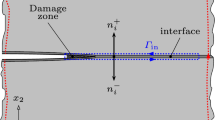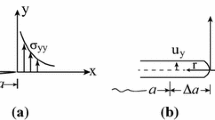Abstract
We investigate numerically the dynamic in-plane propagation of a centered crack along bimaterial interfaces using a spectral formulation of the elastodynamic boundary integral equations. Particular attention is given to the effect of contact zones at the subsonic/intersonic transition. In a single set-up, we simulate and describe the different phenomenon observed experimentally (distinct natures of contact zones, unfavorable velocity range, asymmetric crack propagation). We show that different behaviors are observed as function of the crack propagation direction, i.e., with respect to the particle displacements of the compliant material. When the crack propagates in the same direction, the propagation velocities between \(c_\mathrm{R}\) and \(c_\mathrm{s}\) are forbidden and the subsonic/intersonic transition occurs with the nucleation of a daughter crack in front of the main rupture. The intersonic stress field at the crack front is compressive due to the material mismatch and a contact zone appears behind the tip. In the opposite direction, a smooth subsonic/intersonic transition occurs although crack face closure (in normal direction) is observed for speeds between \(c_\mathrm{s}\) and \(\sqrt{2}c_\mathrm{s}\). In this regime, a Rayleigh disturbance is generated at the crack surface causing a contact zone which detaches from the tip. Using a contact model governed by a regularized Coulomb law, we provide a quantitative evaluation of the influence of friction on the effective fracture toughness. Finally, we show the applicability of our analysis to the description of different bimaterial situations as well as the single-material set-up.















Similar content being viewed by others
References
Andrews DJ (1976) Rupture velocity of plane strain shear cracks. J Geophys Res 81(32):5679–5687
Breitenfeld MS, Geubelle PH (1998) Numerical analysis of dynamic debonding under 2D in-plane and 3D loading. Int J Fract 93(1–4):13–38
Broberg KB (1989) The near-tip field at high crack velocities. Int J Fract 39(1–3):1–13
Burridge R (1973) Admissible speeds for plane-strain self-similar shear cracks with friction but lacking cohesion. Geophys J R Astron Soc 35(4):439–455
Coker D, Rosakis AJ (2001) Experimental observations of intersonic crack growth in asymmetrically loaded unidirectional composite plates. Philos Mag A 81(3):571–595
Coker D, Rosakis A, Needleman A (2003) Dynamic crack growth along a polymer composite-Homalite interface. J Mech Phys Solids 51(3):425–460
Freund LB (1979) The mechanics of dynamic shear crack propagation. J Geophys Res Solid Earth 84(B5):2199–2209
Freund LB (1990) Dynamic fracture mechanics. Cambridge University Press, Cambridge
Geubelle PH, Rice JR (1995) A spectral method for three-dimensional elastodynamic fracture problems. J Mech Phys Solids 43(11):1791–1824
Geubelle PH, Breitenfeld MS (1997) Numerical analysis of dynamic debonding under anti-plane shear loading. Int J Fract 85(3):265–282
Geubelle PH, Kubair DV (2001) Intersonic crack propagation in homogeneous media under shear-dominated loading: numerical analysis. J Mech Phys Solids 49(3) :571–587
Hao S, Liu WK, Klein PA, Rosakis AJ (2004) Modeling and simulation of intersonic crack growth. Int J Solids Struct 41(7):1773–1799
Huang Y, Wang W, Liu C, Rosakis AJ (1998) Intersonic crack growth in bimaterial interfaces: an investigation of crack face contact. J Mech Phys Solids 46(11):2233–2259
Kammer DS, Yastrebov V, Spijker P, Molinari JF (2012) On the propagation of slip fronts at frictional interfaces. Tribol Lett 48(1):27–32
Kammer DS, Yastrebov VA, Anciaux G, Molinari JF (2014) The existence of a critical length scale in regularised friction. J Mech Phys Solids 63:40–50
Kubair DV, Geubelle PH, Huang Y (2002) Intersonic crack propagation in homogeneous media under shear-dominated loading: theoretical analysis. J Mech Phys Solids 50(8):1547–1564
Lambros J, Rosakis AJ (1995) Shear dominated transonic interfacial crack growth in a bimaterial-I. Experimental observations. J Mech Phys Solids 43(2):169–188
Liu C, Huang Y, Rosakis AJ (1995) Shear dominated transonic interfacial crack growth in a bimaterial-II. Asymptotic fields and favorable velocity regimes. J Mech Phys Solids 43(2):189–206
Liu Y, Lapusta N (2008) Transition of mode II cracks from sub-Rayleigh to intersonic speeds in the presence of favorable heterogeneity. J Mech Phys Solids 56(1):25–50
Morrissey JW, Geubelle PH (1997) A numerical scheme for mode III dynamic fracture problems. Int J Numer Methods Eng 40(7):1181–1196
Needleman A (1999) An analysis of intersonic crack growth under shear loading. J Appl Mech 66(4):847–857
Needleman A, Rosakis AJ (1999) The effect of bond strength and loading rate on the conditions governing the attainment of intersonic crack growth along interfaces. J Mech Phys Solids 47(12):2411–2449
Prakash V (1998) Frictional response of sliding interfaces subjected to time varying normal pressures. J Tribol 120(1):97–102
Rosakis AJ, Samudrala O, Singh RP, Shukla A (1998) Intersonic crack propagation in bimaterial systems. J Mech Phys Solids 46(10):1789–1813
Rosakis AJ, Samudrala O, Coker D (1999) Cracks faster than the shear wave speed. Science 284(5418):1337–1340
Rosakis AJ (2002) Intersonic shear cracks and fault ruptures. Adv Phys 51(4):1189–1257
Rubin AM, Ampuero JP (2007) Aftershock asymmetry on a bimaterial interface. J Geophys Res Solid Earth 112(B5):B05,307
Samudrala O, Rosakis AJ (2003) Effect of loading and geometry on the subsonic/intersonic transition of a bimaterial interface crack. Eng Fract Mech 70(2):309–337
Singh RP, Shukla A (1996) Subsonic and intersonic crack growth along a bimaterial interface. J Appl Mech 63(4):919–924
Singh RP, Lambros J, Shukla A, Rosakis AJ (1997) Investigation of the mechanics of intersonic crack propagation along a bimaterial interface using coherent gradient sensing and photoelasticity. Proc R Soc Lond Ser A Math Phys Eng Sci 453(1967):2649–2667
Xia KW, Rousseau CE, Rosakis AJ (2008) Experimental investigations of spontaneous bimaterial interfacial fractures. J Mech Mater Struct 3(1):173–184
Xu XP, Needleman A (1996) Numerical simulations of dynamic crack growth along an interface. Int J Fract 74(4):289–324
Acknowledgments
Most of this work was performed during F. Barras’ internship in the Aerospace Engineering Department at the University of Illinois. The support of the European Research Council (ERCstg UFO-240332) is gratefully acknowledged.
Author information
Authors and Affiliations
Corresponding author
Rights and permissions
About this article
Cite this article
Barras, F., Kammer, D.S., Geubelle, P.H. et al. A study of frictional contact in dynamic fracture along bimaterial interfaces. Int J Fract 189, 149–162 (2014). https://doi.org/10.1007/s10704-014-9967-z
Received:
Accepted:
Published:
Issue Date:
DOI: https://doi.org/10.1007/s10704-014-9967-z




